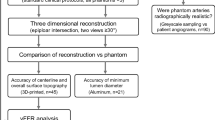Abstract
Purpose
Knowledge of the normal in vivo distribution and variation of coronary ostial locations is essential in the planning of various interventional and surgical procedures. However, all studies to date have reported the distribution of coronary ostia locations only in cadaver hearts. In this study, we sought to assess the distribution of coronary ostial locations in patients using cardiac dual-source computed tomography (CT) and compare these values to those of human cadaveric specimens.
Methods
Measurements of the coronary ostia location were performed in 150 patients undergoing dual-source CT and in 75 cadavers using open measurement techniques. All 150 patients had a normal aortic valve function and no previous cardiac intervention or surgery. The location of the right and left coronary origin in relation to the aortic annulus and the height of the sinus of Valsalva were measured.
Results
Mean ostial locations at CT were 17.0 (±3.6) mm and 15.3 (±3.1) mm for the right and left coronary ostia, with large variations of both sides (right: 10.4–28.5 mm; left: 9.8–29.3 mm). In cadavers, mean locations were 14.9 (±4.3) mm [5–24 mm] for right and 16.0 (±3.6) mm [9–24 mm] for left coronary ostia. Comparison of CT and cadaver data showed statistically significant differences for right (P < 0.0001) but not left (P = 0.1675) coronary ostia.
Conclusions
This study provides data of normal coronary ostial origins and demonstrates significant differences between in vivo and ex vivo measurements regarding the right coronary ostium. The observed large variations of coronary ostia origins emphasize the importance of considering such anatomic variations in the development of treatments.



Similar content being viewed by others
References
Alkadhi H, Scheffel H, Desbiolles L, Gaemperli O, Stolzmann P, Plass A, Goerres GW, Luescher TF, Genoni M, Marincek B, Kaufmann PA, Leschka S (2008) Dual-source computed tomography coronary angiography: influence of obesity, calcium load, and heart rate on diagnostic accuracy. Eur Heart J 29(6):766–776
Babaliaros V, Block P (2007) State of the art percutaneous intervention for the treatment of valvular heart disease: a review of the current technologies and ongoing research in the field of percutaneous valve replacement and repair. Cardiology 107(2):87–96
Berdajs D, Lajos P, Turina M (2002) The anatomy of the aortic root. Cardiovasc Surg 10(4):320–327
Boudjemline Y, Bonhoeffer P (2002) Steps toward percutaneous aortic valve replacement. Circulation 105(6):775–778
Budoff MJ, Achenbach S, Blumenthal RS, Carr JJ, Goldin JG, Greenland P, Guerci AD, Lima JA, Rader DJ, Rubin GD, Shaw LJ, Wiegers SE (2006) Assessment of coronary artery disease by cardiac computed tomography: a scientific statement from the American Heart Association Committee on Cardiovascular Imaging and Intervention, Council on Cardiovascular Radiology and Intervention, and Committee on Cardiac Imaging, Council on Clinical Cardiology. Circulation 114(16):1761–1791
Cavalcanti JS, de Melo NC, de Vasconcelos RS (2003) Morphometric and topographic study of coronary ostia. Arq Bras Cardiol 81(4):359–362, 355-358
Diamond GA, Forrester JS (1979) Analysis of probability as an aid in the clinical diagnosis of coronary-artery disease. N Engl J Med 300(24):1350–1358
Du Bois D, Du Bois EF (1989) A formula to estimate the approximate surface area if height, weight be known 1916. Nutrition 5(5):303–311 (discussion 312–313)
Flecher EM, Curry JW, Joudinaud TM, Kegel CL, Weber PA, Duran CM (2007) Coronary flow obstruction in percutaneous aortic valve replacement an in vitro study. Eur J Cardiothorac Surg 32(2):291–294
Hendel RC, Bateman TM, Cerqueira MD, Iskandrian AE, Leppo JA, Blackburn B, Mahmarian JJ (2005) Initial clinical experience with regadenoson, a novel selective A2A agonist for pharmacologic stress single-photon emission computed tomography myocardial perfusion imaging. J Am Coll Cardiol 46(11):2069–2075
Huber CH, Tozzi P, Corno AF, Marty B, Ruchat P, Gersbach P, Nasratulla M, von Segesser LK (2004) Do valved stents compromise coronary flow? Eur J Cardiothorac Surg 25(5):754–759
Jatene MB, Monteiro R, Guimaraes MH, Veronezi SC, Koike MK, Jatene FB, Jatene AD (1999) Aortic valve assessment. Anatomical study of 100 healthy human hearts. Arq Bras Cardiol 73(1):75–86
Leschka S, Scheffel H, Desbiolles L, Plass A, Gaemperli O, Valenta I, Husmann L, Flohr TG, Genoni M, Marincek B, Kaufmann PA, Alkadhi H (2007) Image quality and reconstruction intervals of dual-source CT coronary angiography: recommendations for ECG-pulsing windowing. Invest Radiol 42(8):543–549
Lutter G, Ardehali R, Cremer J, Bonhoeffer P (2004) Percutaneous valve replacement: current state and future prospects. Ann Thorac Surg 78(6):2199–2206
Muriago M, Sheppard MN, Ho SY, Anderson RH (1997) Location of the coronary arterial orifices in the normal heart. Clin Anat 10(5):297–302
Scheffel H, Alkadhi H, Plass A, Vachenauer R, Desbiolles L, Gaemperli O, Schepis T, Frauenfelder T, Schertler T, Husmann L, Grunenfelder J, Genoni M, Kaufmann PA, Marincek B, Leschka S (2006) Accuracy of dual-source CT coronary angiography: First experience in a high pre-test probability population without heart rate control. Eur Radiol 16(12):2739–2747
Stolzmann P, Scheffel H, Schertler T, Frauenfelder T, Leschka S, Husmann L, Flohr TG, Marincek B, Kaufmann PA, Alkadhi H (2007) Radiation dose estimates in dual-source computed tomography coronary angiography. Eur Radiol 18:592–599
Stolzmann P, Scheffel H, Schertler T, Frauenfelder T, Leschka S, Husmann L, Flohr TG, Marincek B, Kaufmann PA, Alkadhi H (2008) Radiation dose estimates in dual-source computed tomography coronary angiography. Eur Radiol 18(3):592–599
Swanson M, Clark RE (1974) Dimensions and geometric relationships of the human aortic valve as a function of pressure. Circ Res 35(6):871–882
Thubrikar M (1990) The aoric valve. CRC Press, Inc, Boca Raton, Florida, USA
Turner K, Navaratnam V (1996) The positions of coronary arterial ostia. Clin Anat 9(6):376–380
Vlodver Z, Vlodaver Neufeld HN, Edward JE (1975) Coronary arterial variations in the normal heart and in congential heart disease. Academic Press Inc, New York
Acknowledgments
This paper was supported by the National Center of Competence in Research for Computer Aided and Image Guided Medical Interventions (NCCR CO-ME) of the Swiss National Science Foundation.
Author information
Authors and Affiliations
Corresponding author
Rights and permissions
About this article
Cite this article
Knight, J., Kurtcuoglu, V., Muffly, K. et al. Ex vivo and in vivo coronary ostial locations in humans. Surg Radiol Anat 31, 597–604 (2009). https://doi.org/10.1007/s00276-009-0488-9
Received:
Accepted:
Published:
Issue Date:
DOI: https://doi.org/10.1007/s00276-009-0488-9




